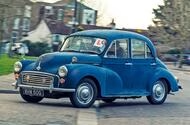Learning to drive is a rite of passage for many young people, but the vehicle you choose can make a world of difference in that experience. Imagine stepping into a classic car, like the charming Morris Minor, instead of a modern hatchback. It might sound quirky, but this choice can be both practical and enriching for new drivers.
Why Choose a Classic Car for Learning?
When you think about learning to drive, the usual suspects come to mind: compact cars like the Ford Fiesta or Volkswagen Polo. But what if you could learn in a car that’s not just a means of transport but a piece of history? For Patrick Wilson, a 17-year-old learner driver, the choice was clear—he’s been honing his skills behind the wheel of a 1968 Morris Minor 1000.
The appeal of a classic car goes beyond nostalgia. For Patrick and his father Ed, the decision was largely financial. Insuring a classic car can be significantly cheaper than a modern vehicle, especially for young drivers. Patrick’s insurance costs just £120 a year, a fraction of what he might pay for a newer model. This affordability is a game-changer, particularly for families on a budget.
The Morris Minor isn’t just about saving money; it’s also about the unique driving experience it offers. Unlike modern cars loaded with technology, the Minor is stripped down to the essentials. It lacks features like synchromesh on first gear and has a foot-operated dip switch, which means Patrick has to engage with the car in a way that many new drivers might not. This hands-on experience fosters a deeper understanding of driving mechanics and encourages a more thoughtful approach to the road.
What’s It Like to Learn in a Classic?
Patrick’s experience learning to drive in the Morris Minor has been eye-opening. While his friends are all learning in modern vehicles, he finds pride in mastering the quirks of a classic. “Most of my friends are learning to drive, but nobody is driving a car as old as ours,” he says. His sister Poppy thinks it’s “really cool,” and that sentiment is echoed by many who see the car on the road.
Driving a classic car like the Minor requires a different mindset. Patrick has to think ahead, especially when approaching junctions or making maneuvers. He admits that driving on the motorway would be intimidating due to the car’s slower speed. Yet, this challenge is precisely what makes him a more skilled driver. He’s learning to anticipate traffic behavior and navigate with caution—skills that will serve him well, regardless of what car he drives in the future.
The Morris Minor also has a certain charm that modern cars lack. Its character, from the dull paintwork to the surface rust, tells a story. For Ed, who learned to drive in a Ford Fiesta, teaching Patrick in the Minor has been a nostalgic journey. He recalls his own learning experience and appreciates the simplicity of the Morris. “It took me a while to adjust to driving the Minor,” he says, but Patrick picked it up quickly, showcasing the adaptability of a new generation.
The Benefits of Learning in an Analog World
In a world dominated by technology, learning to drive in an analog car can be refreshing. Patrick’s experience is a reminder that driving isn’t just about getting from point A to B; it’s about the journey and the skills you develop along the way. He’s picking up valuable lessons that will last a lifetime, even if he eventually transitions to a car equipped with all the modern conveniences.
The big takeaway? Learning to drive in a classic car isn’t about perfection—it’s about smarter adjustments. Whether you’re a parent considering options for your child or a learner yourself, think outside the box. Embrace the quirks and challenges of a classic vehicle, and you might just find that the experience is richer and more rewarding than you ever imagined. So, why not take a page from Patrick’s book? Start with one change this week, and you’ll likely spot the difference by month’s end.

